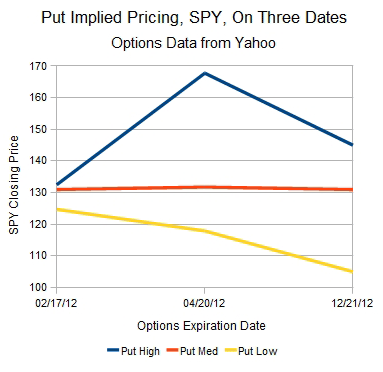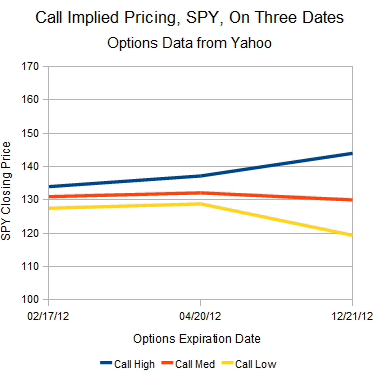Don't Quit Your Day Job is a site which varies between many types of articles - Personal Finance, Politics, Investing, Economics, Random... One of those categories, Investing, has been given short shrift in order to make way for more articles in the other categories. Today we plant a stake; 'Investing' will now have a featured article monthly, where we'll use options to try to determine the outlook for the S&P 500 in the near future. Since this is the first such article, let's discuss the method we will use to predict movement.
Options? Intriguing. How Does Your Method Work?
When you invest in a stock, you have to be right on one aspect: direction. Sure, you want your stock to move in the direction you choose - either increasing in value if you went 'long' and bought shares, or decreasing in value if you went 'short' and sold shares. You have some idea that you want the movement in the near future, and you'd prefer a big move in the proper direction (although you'd certainly be happy for any move).
Options investing brings two new aspects into the game. Options investing, like stock investing, allows you to predict direction. Options contracts also have a defined expiration - so they require you to pick a time-frame. Finally, options contracts have a strike price - the value at which they are declared either in the money or out of the money on the day they expire. In total, with options, you have to predict direction, magnitude, and time-frame.
To the Charts We Go!
I have selected numbers which imply roughly a 75% chance that the price on a certain date will be in my range. That means that one quarter of the time we should see the S&P 500 outside of the predicted range on the expiration date, and three quarters of the time it should fall in the range we predict. This method is based at actual trading values at a point in time (see 'implied volatility', below). That means I'll get two curves - one for the implied prices of 'calls' (roughly the equivalent of going long) and one for the price of puts (roughly the equivalent of going short). Let's take a look (numbers retrieved over weekend - this method uses publicly traded options contracts so the curve continually moves) at numbers for options expiration in Febrary, April, and December. One last note: this information is based on options for the ticker 'SPY', an ETF that tracks the S&P 500, not the index itself.
Implied Volatility
Implied volatility in options prices is the volatility which is priced into an options contract based on an options model. The method I am using is a live model, and uses the closing prices of the options contracts after Friday (options expiration Friday). Basically, implied volatility is a forward looking measurement of how much an instrument will change in value over a period of time.
To the Charts!
First, the charts. Remember, the model implies a 25% chance SPY (our S&P 500 proxy, multiply by 10 for a S&P 500 guide) will close outside the range listed. This first chart is calculated using puts.
The second chart is calculated using calls, and gives predicted closing prices on the same dates.
You can see that as you go further out, the 'spread' for 75% of the price range widens. This makes sense because it should be harder to predict a price for dates further out than immediate. As for our model itself? We'll have to start logging results before we know if it's worthy! Here are the numbers:
| 02/17/12 | 04/20/12 | 12/21/12 | |
| Put High | 132.5 | 167.76 | 145 |
| Put Med | 131 | 131.77 | 131 |
| Put Low | 124.74 | 117.91 | 105 |
| 02/17/12 | 04/20/12 | 12/21/12 | |
| Call High | 134 | 137.21 | 144 |
| Call Med | 131 | 132.11 | 130 |
| Call Low | 127.5 | 128.82 | 119.39 |


